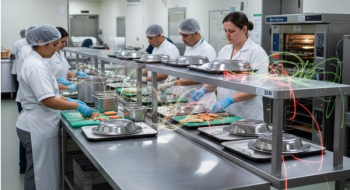
New Survey Says Current Hospital Infection Control Methods Merit Updates
SOMERVILLE, N.J. -- A nationwide survey of hospital
infection control practitioners released today reveals that almost three
quarters (74 percent) believe that current infection control techniques and
technologies need to be updated. However, the survey also revealed that
infection control remains a top priority in U.S. hospitals and 1-in-4
report going beyond current or published guidelines to help ensure patient
health.
The Centers for Disease Control and Prevention (CDC) report that surgical
site infections (SSI) or other serious complications may be directly linked to
various patient risk factors and characteristics(1) (e.g., age, presence of
metabolic disease, nutritional status, weight), the surgical procedure,
medical personnel and the hospital facility. These complications include
failure of the wound to close properly, recurrent pain and disfiguring and/or
disabling scars.(2) Surgical site infections often result in prolonged
hospital stays and increased patient morbidity, both of which have contributed
significantly to driving up direct healthcare costs.(3)
"This study reminds us that infection control is really about improving
patient outcomes and providing a safe environment for patient care. This is
definitely an area where we can make substantial improvements," stated Charles
E. Edmiston, PhD, CIC, associate professor of surgery and hospital
Epidemiologist at the Medical College of Wisconsin in Milwaukee. "We need to
continually update and revise our hospital's protocols to stay abreast of new
advances in the infection control arena."
According to the survey, hospital infection control practitioners
recognize that protecting the surgical site is critical to patient care.
The survey also revealed that 83 percent of respondents believe that advances in the
science of infection control, such as products that actively defend against
microbes, should be used in their institution to combat SSIs.
"Surgical site infections account for a significant number of hospital-
acquired infections and the associated morbidity and mortality is a concern
for both patients and health care professionals," added Edmiston. "The
availability of new innovative technologies or procedures that can potentially
reduce the risk of infection would fall in line with our overall efforts to
decrease the rate surgical site infections, especially in high-risk patient
populations."
Coated VICRYL* Plus Antimicrobial Suture is the first and only
antibacterial suture known to inhibit colonization of the suture by bacteria
that are known to cause the majority of surgical site infections.(4,5) It
creates an "active zone" around the suture, inhibiting staphylococcus aureus,
staphylococcus epidermidis and methicillin resistant strains of staphylococcus
(MRSA and MRSE),(6,7) the leading surgical site bacteria, from colonizing on
the suture for a minimum of 48 hours.(8)
Fifty-three percent of hospital infection control practitioners believe
that regardless of whether their institutions currently use the device or not,
VICRYL Plus suture should be used in the surgical procedures performed at
their institutions, and 54 percent believe it to be logical that a suture that can
inhibit colonization of bacteria may be effective in addressing the problem of
surgical site infection.
The survey was conducted by Harris Interactive. Telephone interviews were
conducted among 301 infection control practitioners Aug. 21-25, 2003. Respondents were selected using a listed sample of infection control
practitioners from the American Hospital Association. In order to participate
in the study, respondents needed to work in an acute-care facility and have
primary responsibility for decisions in the institution related to infection-
control protocols, techniques and technologies. Sampling error for this study
is plus or minus 5.6 percent at the 95 percent confidence level.
The survey was commissioned by ETHICON Products. ETHICON Products, a
division of ETHICON, INC., a Johnson & Johnson company, continues Johnson &
Johnson's 100-year commitment to wound care today with inventive products for
wound closure. ETHICON is the worldwide leader in suture products and suture
technology, and is one of the most recognizable and well-respected names in
the hospital environment. The division has a long history of innovation in
providing products -- including sutures, topical adhesives, surgical meshes
and wound drains -- that enhance patient care. For more information about
ETHICON Products, or other ETHICON divisions, visit http://www.ethicon.com.
Coated VICRYL Plus is an absorbable suture that should not be used where
extended approximation of tissue under stress is required and in patients with
known allergic reactions to triclosan. Side effects of absorbable sutures can
include wound dehiscence, insufficient wound support when wound healing is
delayed, infection, minimal tissue reaction, suture extrusion, delayed
absorption, and calculi formation.
Complete survey results are available by calling (212) 845-4204.
References:
(1) Infection Control and Hospital Epidemiology: Guideline for Prevention
of Surgical Site Infection, 1999
(2) Infection Control Manual: The Medical Center at the University of
California, San Francisco, Revised 3/10
(3) Infection Control and Hospital Epidemiology: Guideline for Prevention
of Surgical Site Infection, 1999
(4) Rothenburger S., Spangler D., Bhende S., Burkley D. In vitro
Antimicrobial Evaluation of Coated VICRYL* Plus Antimicrobial Suture
Using Zone of Inhibition Assays; Surgical Infection Society (SIS)
journal(suppl) Dec 02-In Press.
(5) Infection Control and Hospital Epidemiology: Guideline for
Prevention of Surgical Site Infection, 1999
(6) Rothenburger S., Spangler D., Bhende S., Burkley D. In vitro
Antimicrobial Evaluation of Coated VICRYL* Plus Antimicrobial Suture
Using Zone of Inhibition Assays; Surgical Infection Society (SIS)
journal(suppl) Dec 02-In Press.
(7) Infection Control and Hospital Epidemiology: Guideline for
Prevention of Surgical Site Infection, 1999
(8) Rothenburger S., Spangler D., Bhende S., Burkley D. In vitro
Antimicrobial Evaluation of Coated VICRYL* Plus Antimicrobial Suture
Using Zone of Inhibition Assays; Surgical Infection Society (SIS)
journal(suppl) Dec 02-In Press.
Source: ETHICON
Newsletter
Stay prepared and protected with Infection Control Today's newsletter, delivering essential updates, best practices, and expert insights for infection preventionists.






